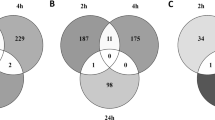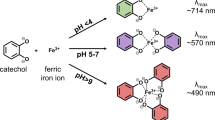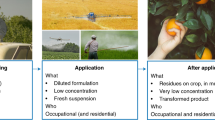Abstract
The use of engineered nanoparticles in food and pharmaceuticals is expected to increase, but the impact of chronic oral exposure to nanoparticles on human health remains unknown. Here, we show that chronic and acute oral exposure to polystyrene nanoparticles can influence iron uptake and iron transport in an in vitro model of the intestinal epithelium and an in vivo chicken intestinal loop model. Intestinal cells that are exposed to high doses of nanoparticles showed increased iron transport due to nanoparticle disruption of the cell membrane. Chickens acutely exposed to carboxylated particles (50 nm in diameter) had a lower iron absorption than unexposed or chronically exposed birds. Chronic exposure caused remodelling of the intestinal villi, which increased the surface area available for iron absorption. The agreement between the in vitro and in vivo results suggests that our in vitro intestinal epithelium model is potentially useful for toxicology studies.
This is a preview of subscription content, access via your institution
Access options
Subscribe to this journal
Receive 12 print issues and online access
$259.00 per year
only $21.58 per issue
Buy this article
- Purchase on Springer Link
- Instant access to full article PDF
Prices may be subject to local taxes which are calculated during checkout





Similar content being viewed by others
References
Sagalowicz, L. & Leser, M. E. Delivery systems for liquid food products. Curr. Opin. Colloid Interface Sci. 15, 61–72 (2010).
Yoav, D. L. Milk proteins as vehicles for bioactives. Curr. Opin. Colloid Interface Sci. 15, 73–83 (2010).
Edgar, A. Bioavailability of nanoparticles in nutrient and nutraceutical delivery. Curr. Opin. Colloid Interface Sci. 14, 3–15 (2009).
Sozer, N. & Kokini, J. L. Nanotechnology and its applications in the food sector. Trends Biotechnol. 27, 82–89 (2009).
Chaudhry, Q. et al. Applications and implications of nanotechnologies for the food sector. Food Addit. Contam. A 25, 241–258 (2008).
Singh, R. & Lillard, J. W. Jr. Nanoparticle-based targeted drug delivery. Exp. Mol. Pathol. 86, 215–223 (2009).
Stone, V. & Kinloch, I. Nanotoxicology: Characterization, Dosing and Health Effects (CRC, 2007).
Lomer, M. C. E., Thompson, R. P. H. & Powell, J. J. Fine and ultrafine particles of the diet: influence on the mucosal immune response and association with Crohn's disease. Proc. Nutr. Soc. 61, 123–130 (2002).
Kerneis, S., Bogdanova, A., Kraehenbuhl, J. P. & Pringault, E. Conversion by Peyer's patch lymphocytes of human enterocytes into M cells that transport bacteria. Science 277, 949–952 (1997).
Lomer, M. C. E., Harvey, R. S. J., Evans, S. M., Thompson, R. P. H. & Powell, J. J. Efficacy and tolerability of a low microparticle diet in a double blind, randomized, pilot study in Crohn's disease. Eur. J. Gastroenterol. Hepatol. 13, 101–106 (2001).
Lomer, M. C. E. et al. Intake of dietary iron is low in patients with Crohn's disease: a case-control study. Br. J. Nutr. 91, 141–148 (2004).
Lee, H. J. Protein drug oral delivery: the recent progress. Arch. Pharm. Res. 25, 572–584 (2002).
Des Rieux, A., Fievez, V., Garinot, M., Schneider, Y. J. & Preat, V. Nanoparticles as potential oral delivery systems of proteins and vaccines: a mechanistic approach. J. Control. Rel. 116, 1–27 (2006).
Galindo-Rodriguez, S. A., Allemann, E., Fessi, H. & Doelker, E. Polymeric nanoparticles for oral delivery of drugs and vaccines: a critical evaluation of in vivo studies. Crit. Rev. Ther. Drug. Carrier Syst. 22, 419–463 (2005).
Ma, Y., Yeh, M., Yeh, K-Y. & Glass, J. Iron imports. V. Transport of iron through the intestinal epithelium. Am. J. Physiol. Gastr. L. 290, G417–G422 (2006).
DeSesso, J. M. & Jacobson, C. F. Anatomical and physiological parameters affecting gastrointestinal absorption in humans and rats. Food. Chem. Toxicol. 39, 209–228 (2001).
Muir, A. & Hopfer, U. Regional specificity of iron uptake by small intestinal brush-border membranes from normal and iron-deficient mice. Am. J. Physiol. Gastr. L. 248, G376–G379 (1985).
Kararli, T. T. Comparison of the gastrointestinal anatomy, physiology, and biochemistry of humans and commonly used laboratory animals. Biopharm. Drug. Dispos. 16, 351–380 (1995).
Sharp, D. G. & Beard, J. W. Size and density of polystyrene particles measured by ultracentrifugation. J. Biol. Chem. 185, 247–253 (1950).
Whittow, G. C. Sturkie's Avian Physiology (Academic, 2000).
Barfull, A., Garriga, C., Mitjans, M. & Planas, J. M. Ontogenetic expression and regulation of Na+-D-glucose cotransporter in jejunum of domestic chicken. Am. J. Physiol. Gastr. L. 282, G559–G564 (2002).
Dahlke, F., Ribeiro, A. M. L., Kessler, A. M., Lima, A. R. & Maiorka, A. Effects of corn particle size and physical form of the diet on the gastrointestinal structures of broiler chickens. Rev. Bras. Cienc. Avic. 5, 61–67 (2003).
Ojano-Dirain, C. P. et al. Determination of mitochondrial function and site-specific defects in electron transport in duodenal mitochondria in broilers with low and high feed efficiency. Poultry Sci. 83, 1394–1403 (2004).
Miles, R. D., Butcher, G. D., Henry, P. R. & Littell, R. C. Effect of antibiotic growth promoters on broiler performance, intestinal growth parameters, and quantitative morphology. Poultry Sci. 85, 476–485 (2006).
Klasing, K. C. Avian gastrointestinal anatomy and physiology. Semin. Avian Exot. Pet 8, 42–50 (1999).
Hidalgo, I. J., Raub, T. J. & Borchardt, R. T. Characterization of the human-colon carcinoma cell-line (Caco-2) as a model system for intestinal epithelial permeability. Gastroenterology 96, 736–749 (1989).
Lesuffleur, T., Barbat, A., Dussaulx, E. & Zweibaum, A. Growth adaptation to methotrexate of HT-29 human colon-carcinoma cells is associated with their ability to differentiate into columnar absorptive and mucus-secreting cells. Cancer Res. 50, 6334–6343 (1990).
Mahler, G. J., Shuler, M. L. & Glahn, R. P. Characterization of Caco-2 and HT29-MTX cocultures in an in vitro digestion/cell culture model used to predict iron bioavailability. J. Nutr. Biochem. 20, 494–502 (2009).
Schulte, R. et al. Translocation of Yersinia enterocolitica across reconstituted intestinal epithelial monolayers is triggered by Yersinia invasin binding to β1 integrins apically expressed on M-like cells. Cell Microbiol. 2, 173–185 (2000).
Giannasca, P. J., Giannasca, K. T., Leichtner, A. M. & Neutra, M. R. Human intestinal M cells display the sialyl Lewis A antigen. Infect. Immun. 67, 946–953 (1999).
Owen, R. L. & Ermak, T. H. Structural specializations for antigen uptake and processing in the digestive-tract. Springer Semin. Immun. 12, 139–152 (1990).
Narai, A., Arai, S. & Shimizu, M. Rapid decrease in transepithelial electrical resistance of human intestinal Caco-2 cell monolayers by cytotoxic membrane perturbents. Toxicol. In Vitro 11, 347–351 (1997).
Ranaldi, G., Marigliano, I., Vespignani, I., Perozzi, G. & Sambuy, Y. The effect of chitosan and other polycations on tight junction permeability in the human intestinal Caco-2 cell line. J. Nutr. Biochem. 13, 157–167 (2002).
Menard, S., Cerf-Bensussan, N. & Heyman, M. Multiple facets of intestinal permeability and epithelial handling of dietary antigens. Mucosal Immunol. 3, 247–259 (2010).
Söderholm, J. D. et al. Increased epithelial uptake of protein antigens in the ileum of Crohn's disease mediated by tumour necrosis factor α. Gut 53, 1817–1824 (2004).
Tako, E., Rutzke, M. A. & Glahn, R. P. Using the domestic chicken (Gallus gallus) as an in vivo model for iron bioavailability. Poultry Sci. 89, 514–521 (2010).
Tako, E. & Glahn, R. P. White beans provide more bioavailable iron than red beans: Studies in poultry (Gallus gallus) and an in vitro digestion/Caco-2 model. Int. J. Vitam. Nutr. Res. 80, 416–429 (2010).
Passaniti, A. & Roth, T. F. Purification of chicken liver ferritin by two novel methods and structural comparison with horse spleen ferritin. Biochem. J. 258, 413–419 (1989).
Mete, A. et al. Partial purification and characterization of ferritin from the liver and intestinal mucosa of chickens, turtledoves and mynahs. Avian Pathol. 34, 430–434 (2005).
Tako, E., Ferket, P. R. & Uni, Z. Changes in chicken intestinal zinc exporter mRNA expression and small intestinal functionality following intra-amniotic zinc-methionine administration. J. Nutr. Biochem. 16, 339–346 (2005).
Smirnov, A., Tako, E., Ferket, P. R. & Uni, Z. Mucin gene expression and mucin content in the chicken intestinal goblet cells are affected by in ovo feeding of carbohydrates. Poultry Sci. 85, 669–673 (2006).
Caspary, W. F. Physiology and pathophysiology of intestinal absorption. Am. J. Clin. Nutr. 55, 299S–308S (1992).
Pluske, J. R. et al. Maintenance of villus height and crypt depth, and enhancement of disaccharide digestion and monosaccharide absorption, in piglets fed on cows’ whole milk after weaning. Br. J. Nutr. 76, 409–422 (1996).
Tarachai, P. & Yamauchi, K. Effects of luminal nutrient absorption, intraluminal physical stimulation, and intravenous parenteral alimentation on the recovery responses of duodenal villus morphology following feed withdrawal in chickens. Poultry Sci. 79, 1578–1585 (2000).
Basu, T. K. & Donaldson, D. Intestinal absorption in health and disease: micronutrients. Best Pract. Res. Clin. Gastroenterol. 17, 957–979 (2003).
Hilty, F. M. et al. Iron from nanocompounds containing iron and zinc is highly bioavailable in rats without tissue accumulation. Nature Nanotech. 5, 374–380 (2010).
NRC. Nutrient Requirements of Poultry 9th edn (National Academy Press, 1994).
Acknowledgements
The authors acknowledge financial support from the National Science Foundation for the Nanobiotechnology Center at Cornell University (ECS-9876771), the New York State Office of Science, Technology and Academic Research (for a Distinguished Professorship for M.L.S.), the Army Corp of Engineers (ID W9132T-07-2-0010) and the US Department of Agriculture. The HT29-MTX cell line was kindly contributed by Thécla Lesuffleur (INSERM U560).
Author information
Authors and Affiliations
Contributions
G.J.M., M.B.E., S.D.A., R.P.G. and M.L.S. conceived and designed the experiments. G.J.M. performed the in vitro studies. G.J.M., M.B.E. and E.T. handled the chickens daily and E.T. and R.P.G. performed the chicken surgery. E.T. performed the microbiological analysis and M.B.E. prepared the histological samples. T.L.S. analysed the histology samples. G.J.M., M.B.E. and E.T. analysed the data. All authors co-wrote the paper.
Corresponding author
Ethics declarations
Competing interests
The authors declare no competing financial interests.
Supplementary information
Supplementary information
Supplementary information (PDF 1752 kb)
Rights and permissions
About this article
Cite this article
Mahler, G., Esch, M., Tako, E. et al. Oral exposure to polystyrene nanoparticles affects iron absorption. Nature Nanotech 7, 264–271 (2012). https://doi.org/10.1038/nnano.2012.3
Received:
Accepted:
Published:
Issue Date:
DOI: https://doi.org/10.1038/nnano.2012.3
This article is cited by
-
Nitrogen forms and concentration influence the impact of titanium dioxide nanoparticles on the biomass and antioxidant enzyme activities of Microcystis aeruginosa
Archives of Microbiology (2023)
-
Micro(nano)plastic pollution in terrestrial ecosystem: emphasis on impacts of polystyrene on soil biota, plants, animals, and humans
Environmental Monitoring and Assessment (2023)
-
Microplastics in environment: global concern, challenges, and controlling measures
International Journal of Environmental Science and Technology (2023)
-
Steam disinfection releases micro(nano)plastics from silicone-rubber baby teats as examined by optical photothermal infrared microspectroscopy
Nature Nanotechnology (2022)



